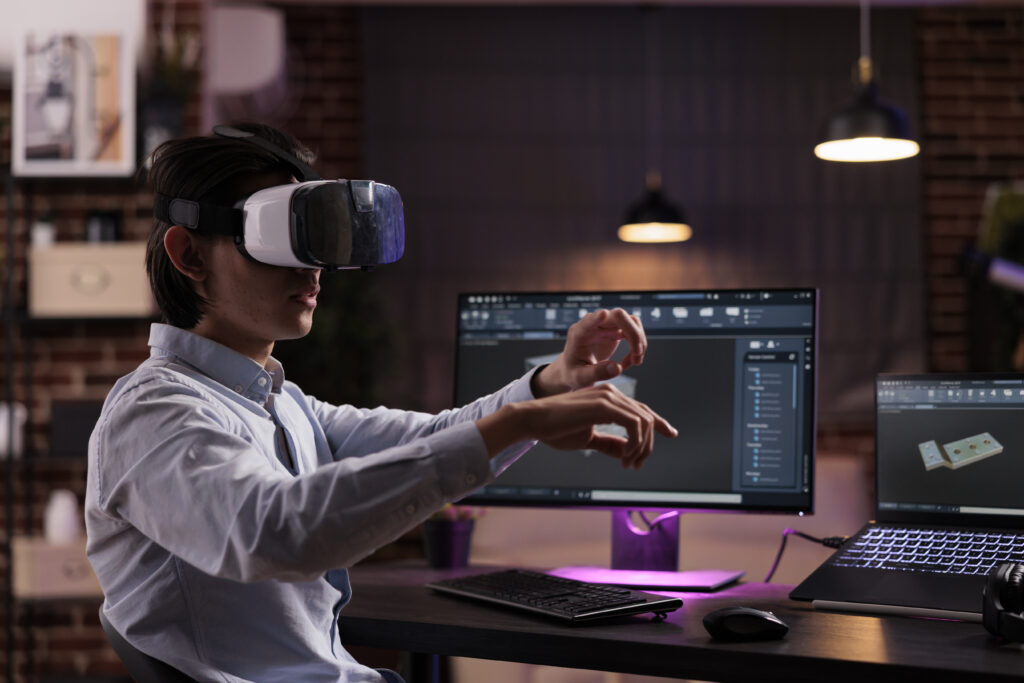In an era where technology is advancing at an unprecedented pace, the boundaries between the real and virtual worlds are becoming increasingly blurred. In this scenario, the virtual world designer is the professional who creates these virtual worlds. But what is the salary of a virtual world designer?
Virtual reality (VR) and augmented reality (AR) have emerged as innovative platforms that offer immersive experiences to users, and at the heart of these experiences lie the creative minds of virtual world designers.
These professionals are tasked with crafting captivating and interactive digital realms, but what exactly does their compensation look like in this evolving landscape? What exactly do they do?
Let’s discuss these aspects in this article and hopefully clarify some details of this profession for you.

What is the salary of a virtual world designer?
Determining what is the salary of a virtual world designer can be influenced by several key factors.
As with many professions, experience plays a pivotal role in salary determination. Junior designers with limited experience might start with a more modest salary, which increases as their skills and portfolio expand.
Geographical location can also impact salary levels. Designers working in tech hubs like Silicon Valley or major metropolitan areas tend to command higher salaries due to the higher cost of living and increased demand for their skills.
The industry in which a virtual world designer works can also impact their earning potential. For instance, designers contributing to high-budget gaming projects or large-scale architectural simulations may find themselves more generously compensated.
A bachelor’s or master’s degree in fields such as game design, computer science, or interactive media can contribute to a higher starting salary.
With all these elements taken into account, on average, entry-level designers can expect to earn anywhere from $50,000 to $70,000 annually.
Mid-level designers with a few years of experience can earn between $70,000 and $100,000, while experienced designers with a solid track record might command salaries ranging from $100,000 to $150,000 or more.

The role of a virtual world designer
As important as understanding what is the salary of a virtual world designer is to understand what exactly is their job.
Virtual world designers can be likened to the architects of the digital realm, bearing the responsibility of conceiving intricate virtual environments that users can seamlessly interact with.
Much like artists, they wield a palette of creativity interwoven with profound technical knowledge to construct digital spaces that can captivate and enrapture users’ senses and imaginations.
The artistry of virtual world designers ranges from the creation of virtual landscapes to the meticulous construction of sprawling cityscapes that mirror the complexity of real urban centers.
Through the fusion of artistic vision and technological prowess, these designers craft immersive realms that transcend the confines of reality, allowing users to traverse through realms that are limited only by the extent of human creativity.
To do all that, virtual world designers have a vast and diverse skill set at their disposal. While their work is evident in the gaming and entertainment sectors, their influence can go far beyond them.
These immersive digital landscapes find purpose and value across industries such as education, where history can be experienced firsthand, or complex medical procedures can be simulated.
Virtual worlds also have an application in healthcare, where therapeutic environments can be constructed for mental well-being; architecture and real estate, where clients can virtually explore properties that are still on the drawing board; and even urban planning, where potential city layouts can be visualized and assessed in a virtual space before any construction begins.

The future of the profession
You know what is the salary of a virtual world designer now, but what about the future? Does the profession have room to grow?
The future of the virtual world designer profession holds a fascinating and dynamic trajectory, propelled by the rapid evolution of technology and the growing integration of virtual reality into various aspects of our lives.
The demand for virtual world designers is set to expand across an array of industries beyond gaming and entertainment. Sectors like the ones we mentioned above will increasingly adopt VR as a means of communication, training, and visualization.
This will necessitate specialized virtual world designers who understand the unique needs of each industry and can create tailored experiences.
And as the field matures, we can expect to see more specialization within the virtual world designer profession.
Some designers might focus on medical simulations, while others might specialize in architectural visualization, corporate training, or social VR experiences.
Specialization will enable designers to refine their skills and cater to specific niches, resulting in more sophisticated and contextually relevant virtual worlds.
Another very relevant aspect is that virtual world designers will increasingly collaborate with professionals from diverse fields, like psychologists, neuroscientists, architects, UX designers, and AI specialists.
This cross-pollination of ideas will elevate the quality of virtual worlds, making them more intuitive and impactful, leading to more immersive and psychologically engaging experiences.
In essence, the future of the virtual world designer profession is bound to be exciting and transformative.
As technology continues to advance and our understanding of human interaction with virtual environments deepens, virtual world designers will play a pivotal role in shaping how we experience, learn, communicate, and create in the digital realm.

We here at Main Leaf, throughout our 11 years of experience in the world of game design, have seen the birth and evolution of the profession, and we know how important virtual world designers are going to be in the future.
If you liked our article, don’t forget to check many others in our blog. And if you need help designing a game, you can always contact us to learn more about our company and our products.
We’ll answer you within 24 hours!

